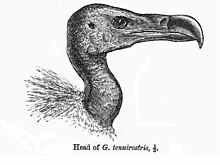| Revision as of 06:18, 29 January 2008 editJerryFriedman (talk | contribs)Autopatrolled, Extended confirmed users, Pending changes reviewers12,650 edits →References: fix IUCN ref← Previous edit | Revision as of 15:20, 27 February 2008 edit undoEubot (talk | contribs)259,670 editsm Removed taxobox colour. See User:Eubot/Removing colours from taxoboxen.Next edit → | ||
| Line 1: | Line 1: | ||
| {{Taxobox | {{Taxobox | ||
| | color = pink | |||
| | name = Slender-billed Vulture | | name = Slender-billed Vulture | ||
| | status = CR | | status = CR | ||
Revision as of 15:20, 27 February 2008
| Slender-billed Vulture | |
|---|---|

| |
| Head of Gyps tenuirostris | |
| Conservation status | |
| Critically endangered | |
| Scientific classification | |
| Kingdom: | Animalia |
| Phylum: | Chordata |
| Class: | Aves |
| Order: | Falconiformes |
| Family: | Accipitridae |
| Genus: | Gyps |
| Species: | G. tenuirostris |
| Binomial name | |
| Gyps tenuirostris | |
| Synonyms | |
|
Gyps indicus tenuirostris | |
The Slender-billed Vulture (Gyps tenuirostris) is a recently recognized species of Old World vulture. For some time, it was lumped with its relative the Indian Vulture under the name of "Long-billed Vulture". However, these two species have parapatric or allopatric ranges and can be immediately told apart by trained observers, even at considerable distances.
This species has suffered a marked decline in its numbers in recent years. Wild populations remain from northern and eastern India through southern Nepal and Bangladesh, with a small population in Burma. The only breeding colony in Southeast Asia is in the Steung Treng province of Cambodia. This colony is thought to number about 50–100 birds. The survival of the vultures in Cambodia may have been partly because diclofenac, which is poisonous to vultures, is not available there.
Conservation
The Slender-billed Vulture is a protected species listed on the appendix II list of CITES, because its numbers have declined rapidly. Its decline is largely due to the use of the non-steroidal anti-inflammatory drug (NSAID) diclofenac in working farm animals, especially in India. Diclofenac is poisonous to vultures, causing kidney failure, and is being replaced by meloxicam (another NSAID), which is not toxic to Vultures.
Captive-breeding programs in India are aiming to conserve the species, and it is hoped that vultures can be released back in the wild when the environment is free of diclofenac.
References
- Colony of Endangered Vultures Discovered in Cambodia
- birdlife.org
- BirdLife International 2004. Gyps tenuirostris. In: IUCN 2007. 2007 IUCN Red List of Threatened Species. Downloaded on 29 January 2008.
External links
This Falconiformes article is a stub. You can help Misplaced Pages by expanding it. |